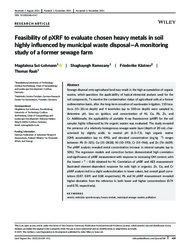Feasibility of pXRF to evaluate chosen heavy metals in soil highly influenced by municipal waste disposal—A monitoring study of a former sewage farm
DOI: https://doi.org/10.1002/ldr.4147
Persistent URL: http://resolver.sub.uni-goettingen.de/purl?gldocs-11858/9857
Persistent URL: http://resolver.sub.uni-goettingen.de/purl?gldocs-11858/9857
Sut‐Lohmann, Magdalena; Ramezany, Shaghayegh; Kästner, Friederike; Raab, Thomas, 2022: Feasibility of pXRF to evaluate chosen heavy metals in soil highly influenced by municipal waste disposal—A monitoring study of a former sewage farm. In: Land Degradation & Development, Band 33, 3: 439 - 451, DOI: 10.1002/ldr.4147.
 |
Dokument öffnen: |
Sewage disposal onto agricultural land may result in the high accumulation of organic wastes, which questions the applicability of typical elemental analysis used for the soil components. To monitor the contamination status of agricultural soils at a former sedimentation basin, after the long‐term cessation of wastewater irrigation, 110 locations (15–20 cm depth) and 4 boreholes (up to 100 cm depth) were sampled to determine pH, loss on ignition, and concentration of Ni, Cu, Pb, Zn, and Cr. Additionally, the applicability of portable X‐ray fluorescence (pXRF) for the soil samples highly influenced by the organic wastes was evaluated. The study revealed the presence of a relatively homogenous sewage waste layer (depth of 20 cm), characterized by slightly acidic to neutral pH (6.3–7.5), high organic matter (OM) accumulation (up to 49%), and elevated concentration (mg kg −1) ranges between: Pb (5–321), Cu (31–2828), Ni (10–193), Cr (14–966), and Zn (76–6639). The pXRF analysis revealed metal concentration increase in mineral samples (up to 50%). The regression models and correction factors demonstrated high correlation and significance of pXRF measurement with response to increasing OM content, with the lowest r 2 = 0.86 obtained for Ni. Correlation of pXRF and AES measurement illustrated element‐dependent response for soils high in organics. Zn, Cu, and Cr pXRF analysis led to a slight underestimation in lower values, but overall good correlations (0.87; 0.89; and 0.88 respectively). Pb and Ni pXRF measurement revealed higher deviation from the reference in both lower and higher concentrations (0.74 and 0.70, respectively).
Statistik:
ZugriffsstatistikSammlung:
This is an open access article under the terms of the Creative Commons Attribution‐NonCommercial‐NoDerivs License, which permits use and distribution in any medium, provided the original work is properly cited, the use is non‐commercial and no modifications or adaptations are made.

